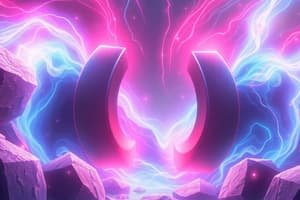Podcast
Questions and Answers
What are the two distinct poles that magnets possess?
What are the two distinct poles that magnets possess?
- North pole and south pole (correct)
- Left pole and right pole
- Up pole and down pole
- East pole and west pole
How do like poles of magnets interact with each other?
How do like poles of magnets interact with each other?
- Attract
- Rotate
- Repel (correct)
- Neutralize
Which of the following best describes the interaction between magnets with opposite poles?
Which of the following best describes the interaction between magnets with opposite poles?
- They rotate around a central point
- They attract each other (correct)
- They cancel each other's magnetism
- They repel each other
What is the primary function of electric motors in various devices?
What is the primary function of electric motors in various devices?
Which application of magnets involves transferring electrical energy between circuits?
Which application of magnets involves transferring electrical energy between circuits?
What do magnetic forces arise from?
What do magnetic forces arise from?
What type of magnets lose their magnetic properties when the external magnetic field is removed?
What type of magnets lose their magnetic properties when the external magnetic field is removed?
Which type of magnets are widely used due to their low cost and ease of manufacturing?
Which type of magnets are widely used due to their low cost and ease of manufacturing?
What type of magnets are created using a coil of wire and an electric current?
What type of magnets are created using a coil of wire and an electric current?
In which application are neodymium magnets commonly used due to their high magnetic strength?
In which application are neodymium magnets commonly used due to their high magnetic strength?
What is the space around a magnet where magnetic forces can be detected called?
What is the space around a magnet where magnetic forces can be detected called?
Which quantity is used to describe the strength of a magnetic field created by moving electric charges?
Which quantity is used to describe the strength of a magnetic field created by moving electric charges?
Flashcards are hidden until you start studying
Study Notes
Magnets: Exploring Their Poles, Forces, Applications, and Fields
Magnetism is a fundamental force that has profoundly impacted human civilization through the discovery and application of magnets. In this article, we'll delve into the essential aspects of magnets, starting with their poles, forces, and ending with their diverse applications and types. We'll also explore the concept of magnetic fields.
Magnetic Poles
Magnets possess two distinct poles: the north pole (N) and the south pole (S). These poles always face opposite directions and are attracted to their respective counterparts. Magnetic poles are endpoints of magnetic fields, and like poles (N and N or S and S) repel each other, while unlike poles (N and S) attract.
Magnetic Forces
Magnetic forces arise from the interaction between magnets and the movement of electrically charged particles. These forces are responsible for the numerous applications of magnets. When two magnets with opposite poles are brought close together, they attract one another, while magnets with like poles repel.
Applications of Magnets
Magnetic forces are harnessed in many applications. Some of these include:
- Electric motors: Converting electrical energy into mechanical work, they are used in various devices, such as fans, washing machines, and electric cars.
- Electromagnetic induction: Used in transformers and generators to transfer electrical energy between circuits.
- Magnetic levitation (maglev): High-speed trains that use magnetic forces to hover above a guideway without touching it, reducing friction and increasing speed.
- Magnetic resonance imaging (MRI): A medical imaging technique that uses strong magnetic fields and radio waves to generate detailed images of internal structures.
- Hard disk drives: Data storage devices where magnetic fields manipulate tiny magnetic particles to store information.
- Magnetic separation: A process used in mineral processing and wastewater treatment to separate and concentrate particulate matter.
Types of Magnets
There are several types of magnets, each with unique properties and applications:
- Permanent magnets: These magnets retain their magnetic properties without the need for an external magnetic field, made of materials such as iron, nickel, and cobalt.
- Electromagnets: Created using a coil of wire and an electric current, they are used in devices like electric motors and magnetic separators.
- Temporary magnets: These magnets lose their magnetic properties when the external magnetic field is removed, such as iron filings that are temporarily magnetic when placed in a magnetic field.
- Ferrite magnets: Made of ferrite, a ceramic, they are widely used because of their low cost and ease of manufacturing.
- Neodymium magnets: Highly powerful permanent magnets made of a rare-earth material, they are used in applications that require higher magnetic strength.
Magnetic Fields
Magnetic fields are the space around a magnet where magnetic forces can be detected. They are created by moving electric charges, magnetic moments, and currents. Magnetic fields can be represented by field lines, which are invisible lines of force that connect magnetic poles.
Magnetic fields can be described using two quantities: magnetic field strength (B) and magnetic flux density (H). Magnetic fields are essential for understanding the interactions between magnets and the behavior of magnetic materials.
In summary, magnets are one of the most fascinating phenomena in the natural world, with their magnetic poles, forces, and applications impacting daily life. Understanding magnets and their properties is essential for the innovation and advancement of technology.
Studying That Suits You
Use AI to generate personalized quizzes and flashcards to suit your learning preferences.




